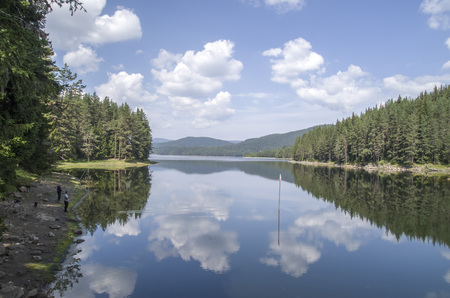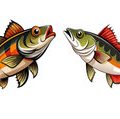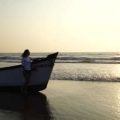Introduction to Bass Fishing Culture in the U.S.
When it comes to quintessential American outdoor pastimes, bass fishing stands tall as a time-honored tradition. From the winding rivers of the Midwest to the sun-drenched lakes of the South, generations have cast their lines in pursuit of largemouth and smallmouth bass. This isn’t just about catching fish—it’s about connecting with nature, unwinding from the daily grind, and embracing the rugged freedom that defines American recreation. Over the decades, bass fishing has evolved from a humble hobby into a full-blown phenomenon, fueled by innovations in gear, legendary tournaments like the Bassmaster Classic, and a community that spans every corner of the country. Today, millions of anglers—weekend warriors and seasoned pros alike—hit public waters with one thing in mind: landing that trophy bass. These public access lakes are more than just fishing holes; they’re living testaments to America’s enduring love affair with bass fishing. As we dive deeper, we’ll chart out some of the nation’s most celebrated public access lakes for prime bass action—each one offering its own flavor of excitement, challenge, and untamed beauty.
Lake Fork, Texas: The Lone Star State’s Lunker Magnet
If you’re hunting for true trophy bass in the heart of Texas, Lake Fork should be at the top of your hit list. This East Texas reservoir has earned its stripes as a certified mecca for lunker largemouths, regularly producing double-digit monsters that make even seasoned pros sweat. Let’s break down what makes Lake Fork the big-bass capital, and how you can tap into its legendary action—whether you’re rolling solo or rolling up with your crew.
Why Lake Fork Is Ground Zero for Trophy Bass
Lake Fork was engineered from day one to be a bass haven—stocked with Florida-strain largemouths and managed by aggressive slot limits (16-24 inches must be released) that let the big girls grow huge. Fertile waters loaded with shad, abundant timber, and creek channels create prime ambush spots for chunky bass. Nearly 65% of Texas’ top 50 largemouths have come from Fork, and it’s still producing giants today.
Public Access Points: Where to Launch & Bank Fish
| Access Point | Type | Location/Details |
|---|---|---|
| Lake Fork Marina | Boat Ramp & Bank Fishing | Hwy 17 N, Alba—Popular with tournament anglers |
| SRA Public Ramp #1 | Boat Ramp | Dam area off Hwy 515—Open year-round, no fee |
| East Fork Park | Bank Fishing & Picnic Area | Northeast shoreline—Good shore access for families |
| Hideaway Harbor Park | Boat Ramp & Pier | South end off FM 2946—Less crowded option |
Seasonal Tactics That Hook Giants
- Spring (March–May): Spawning time is magic hour. Hit shallow coves and creek arms with soft plastics or jigs around submerged timber. Sight-fishing beds can land you a personal best.
- Summer (June–August): Big girls move deeper. Target main-lake points and ledges with crankbaits or Carolina rigs in 10-20 feet of water. Early mornings are clutch for topwater bites near grass lines.
- Fall (September–November): Shad migration brings bass shallow again. Work squarebill crankbaits and spinnerbaits along creek mouths and flats.
- Winter (December–February): Slow down with jigs and suspending jerkbaits near deep structure. Electronics help pinpoint schools hugging timber drops.
Local Angler Hacks: Tips From the Pros Who Grind Here Daily
- Ditch the crowds: Weekdays see less pressure than weekends, especially away from major ramps.
- Trophy hunt after fronts: Post-frontal bluebird days push big bass tight to cover—pitch jigs into thick stuff for surprise giants.
- Bait matters: Local guides swear by watermelon red flake worms and oversized swimbaits when targeting true hawgs.
- Cautious release: Slot limits mean CPR (Catch, Photo, Release) is king—handle fish gently to protect the gene pool.
If you want a shot at a personal-best largemouth in public waters, few places deliver like Lake Fork. Bring stout gear, patience, and respect for local regulations—and get ready to tangle with some of the baddest bass in America.
![]()
3. Clear Lake, California: West Coast Bass Hotspot
Legendary Waters, Legendary Action
If you’re gunning for heavyweight largemouth and want to fish in a place that’s etched into American bass lore, Clear Lake, California, should be at the top of your list. As the oldest natural lake in the Golden State—and one of the most productive bass fisheries on the West Coast—Clear Lake delivers the kind of hard-hitting action that serious anglers crave. This public access gem is famous for both numbers and size, with double-digit bass caught here every year.
Tactics That Dominate at Clear Lake
Clear Lake’s shallow flats, submerged vegetation, and rocky points set the stage for a wide range of techniques. In spring, sight-fishing with soft plastics like Senkos or creature baits can be lights-out during the spawn. When summer heats up, switch gears to topwater frogs in thick weed mats at dawn—explosive blowups are the rule, not the exception. Crankbaits and chatterbaits work magic along riprap and docks year-round, while flipping jigs into tules or under docks often bags those kicker fish locals brag about.
Why Serious Bass Hunters Choose Clear Lake
What really makes Clear Lake stand out isn’t just its consistent trophy potential—it’s the combination of easy public access ramps, ample shoreline opportunities, and a tournament pedigree that draws pros from across the nation. Whether you’re fishing solo from a kayak or running-and-gunning from a high-powered bass boat, you’ll find more than enough water to explore. Add in a mild climate and year-round bite, and it’s clear why this lake is a bucket-list destination for any hardcore bass angler looking to test their mettle on legendary waters.
4. Chickamauga Lake, Tennessee: The Heart of Southern Bass Fishing
When it comes to legendary bass waters, Chickamauga Lake sits at the top of many anglers bucket lists. This Tennessee reservoir is notorious for producing monster largemouths—some tipping the scales at double digits. If you’re after trophy fish with public access, Chickamauga delivers the goods.
Bank Fishing Hotspots
While boaters roam miles of submerged grass beds, bank anglers have solid opportunities too. Key public-access bank spots include:
| Bank Spot | Location | Best Time |
|---|---|---|
| Chester Frost Park | Northern section near Hixson | Spring and early summer mornings |
| Harrison Bay State Park | Eastern shoreline off Highway 58 | Late evening, year-round |
| Tennessee Riverpark Piers | Near Amnicola Hwy in Chattanooga | Post-spawn and fall afternoons |
Top-Rated Public Ramps for Easy Launches
Launching your rig is a breeze at these trusted ramps—used by locals and pros alike:
- Wolftever Creek Boat Ramp: Spacious parking and quick access to main-lake points.
- Soddy Lake Boat Ramp: Gets you close to deep ledges where big bass lurk in summer.
- Booker T. Washington State Park Ramp: Great for both shore fishing and boat launches; hosts several tournaments each year.
Bass-Catching Techniques That Locals Swear By
If you want numbers—and size—here’s how the local sticks get it done on Chickamauga:
- Punching Mats: Heavy tungsten weights and creature baits flipped into thick hydrilla mats during midday heat produce jaw-dropping bites.
- Cranking Shell Beds: Deep-diving crankbaits over rocky shell bars hold kicker fish, especially in pre-spawn months.
- Nighttime Topwater: When temps soar, late-night missions with buzzbaits and walking baits on shallow flats can be electric.
- Ned Rigging Points: Finesse plastics on light heads fished along main-lake points pick up pressured bass that ignore bigger offerings.
If You’re Gunning for a Record Largemouth…
The lake’s current record is over 15 pounds, but every spring brings fresh rumors of giants lost or landed. Stick close to grass edges, focus on current breaks near river channels, and don’t be afraid to throw oversized swimbaits when the moon is high. Chickamauga isn’t just a lake—it’s an institution for anyone serious about bagging their personal best bass.
5. Lake Okeechobee, Florida: The Big O Experience
When you’re talking about legendary bass lakes in the U.S., Lake Okeechobee—affectionately known as “The Big O”—sits at the top of any serious angler’s bucket list. This sprawling Florida giant is not only one of the largest freshwater lakes in the country but also a public-access hotspot for world-class largemouth action. If you want a taste of real Florida-style bassin’, this is where you learn to fish tough and smart.
Punching Through Thick Vegetation
Okeechobee is famous for its dense mats of hydrilla, hyacinth, and lily pads. Here, finesse gets left at the dock—it’s all about heavy gear and punch rigs. Rig up with a stout rod, braided line (50-65 lb.), and a compact soft plastic paired with a 1- to 1.5-ounce tungsten weight. You need that muscle to drive your bait through the thick stuff where monster bass love to hide from the Florida sun. Don’t be afraid to get your hands dirty—dig deep into those mats and hold on tight.
Navigating the Jungle
Okeechobee’s endless vegetation can be intimidating if you don’t know what to look for. Focus on transition areas—edges where grass meets open water or where different types of vegetation collide. These are prime ambush spots for big bass. Keep an eye out for isolated reed clumps or pockets in the grass; they often hold fish that see less pressure from other anglers.
Abundant Shoreline Access
One of The Big O’s biggest draws is its accessibility. From Clewiston to Belle Glade, there are numerous public boat ramps and fishing piers dotting the shoreline. Even bank anglers get a fair shot here—hit up canals and levees along the rim for surprisingly solid catches. Whether you’re slinging baits from shore or punching mats from a boat, Lake Okeechobee delivers that classic South Florida adrenaline rush every time you set the hook.
6. Northern Gems: Mille Lacs (Minnesota) & Lake St. Clair (Michigan)
Smallmouth Strongholds of the North
If your idea of a bass trophy is a thick, bronze-backed smallmouth, Mille Lacs and Lake St. Clair are your northern go-tos. Both lakes rank in the U.S. smallmouth elite, drawing diehard anglers from all over the country every season.
Mille Lacs: Minnesota’s Bronzeback Beast Factory
Mille Lacs isn’t just a walleye hotspot—it’s ground zero for football-sized smallies. The best action fires up in late spring when post-spawn fish pile onto shallow rock reefs and gravel flats. Public access is excellent, with launches like Liberty Beach and Garrison Landing offering direct shots at top structure. In summer, follow the bronzebacks to deeper humps and edges with drop shot rigs or Ned rigs—don’t be afraid to bounce a tube jig along those rocky breaks.
Lake St. Clair: Michigan’s Smallmouth Mecca
St. Clair is legendary for numbers and size—think five-pounders stacked on scattered weedbeds and sandy patches. Early summer brings pre-spawn giants shallow, and you’ll find public ramps at Harley Ensign DNR Launch and Metropark Marina putting you right in the game. As water warms, drift or troll the expansive flats with jerkbaits and spinnerbaits; target transition zones where sand meets grass for non-stop action.
Local Tactics & Hotspots
For both lakes, timing is everything. Spring sees aggressive feeders up shallow—ideal for topwaters and swimbaits. By midsummer, downsize your presentation and work deeper breaks with finesse plastics. Both fisheries have ample public access, so there’s no excuse not to chase those northern bronzebacks.
7. Essential Public Lake Tactics & Responsible Angling
Fishing public access lakes for bass in the U.S. is a whole different beast compared to secluded private ponds. These waters see heavy pressure, so you need hard-hitting tactics and a conservation mindset if you want to consistently put bass in the boat—and help keep those fisheries healthy for everyone.
Battle-Tested Tactics for Pressured Public Lakes
Downsize Your Presentation
On public lakes, bass see every lure in the catalog. When they get lockjaw, switch to finesse rigs—think Ned rigs, drop shots, or weightless Senkos on light line. Downsizing your bait and slowing your retrieve can be the difference between getting skunked and hitting a limit.
Target Overlooked Structure
Most anglers pound the obvious spots: docks, points, weed edges. To beat the crowd, look for less-pressured cover—submerged brush, isolated rock piles, or secondary points off main lake channels. Use electronics to locate these sweet spots and fish them thoroughly.
Hit the Water Early (or Late)
Prime time on pressured lakes is sunrise and sunset. Bass are more active and less wary before the crowds arrive or after they leave. Night fishing with topwaters or big worms can also produce trophy bites when everyone else is off the water.
Mix Up Your Approach
If you’re not getting bites, don’t be afraid to experiment—change colors, try reaction baits like chatterbaits or squarebills, or fish deeper water as the sun rises. Adaptability is key on public lakes where conditions (and pressure) change daily.
Responsible Angling: Keep America’s Lakes Thriving
Practice Catch & Release
Bass are America’s favorite sportfish for a reason. Handle fish with care—wet your hands before grabbing them, support their belly, and get them back in the water quickly. Letting those bigger bass go helps maintain strong genetics and future populations.
Respect Local Regulations
Every state sets its own rules for bag limits, slot sizes, and seasons. Know the regulations for each lake you fish—and follow them to a tee. Conservation officers take this seriously, and so should you if you want to protect our fisheries.
Leave No Trace
This one’s simple: pack out what you pack in. Trash, line clippings, and broken tackle all harm wildlife and spoil the experience for everyone else. Take pride in leaving your spot better than you found it.
The Bottom Line
Catching big bass from public access lakes takes grit, smarts, and respect—for both the fish and your fellow anglers. Master these proven tactics while practicing responsible angling, and you’ll enjoy epic days on America’s most accessible bass waters for years to come.


